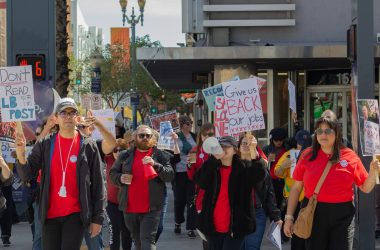Common procedure for handling a physically abusive relationship is to call the authorities and get away from the abuser as quickly as possible — Mimi Kim said she believes there’s another way.
With a renewal of a two-year grant from the Blue Shield Foundation of California, Kim, assistant professor for Cal State Long Beach’s School for Social Work, has been working on a separate approach to handling abuse in her Creative Interventions program, and now her latest in Strengthening Social Network Responses to Domestic Violence.
The domestic violence pilot launched in 2015 and is an extension of Kim’s project, Creative Interventions. It ran from 2004 to 2010 as an effort to provide more options to victims of domestic violence. Kim calls her method, “restorative justice,” which places an emphasis on teaching communities how to prevent and intervene in instances of domestic violence. Kim developed these methods in her time with CI and is now working with local organizations such as California Conference for Equality and Justice and Khmer Girls in Action in order to change how domestic violence is handled. “Restorative justice” facilitates conversations between survivors, loved ones and abusers to work toward a solution.
“We don’t just leave [survivors] alone and let them do whatever they want with their friends and family,” Kim said. “I think people have been doing that, but largely on their own because a lot of us in the anti-violence movement would not support [survivors] in exploring other options. What we’re saying now is ‘what can we do to best support them and explore these options?’”
Typically, the solution to a domestic violence case is to separate the individuals in conflict until legal action can be taken. After seeking refuge, legal proceedings such as criminal charges, restraining orders, divorce or perhaps even a child custody case can be executed. This is provided the survivor wants to press charges at all, which isn’t always the case. According to Katie Ray-Jones, president of the the National Domestic Violence Hotline and the National Dating Abuse Helpline, it can take an average of seven tries to leave an abusive relationship.
“It’s really important for her to make the decision to leave. He’s controlling decision-making, so if you seem to control her decision as well, it’s not good,” Ray-Jones told CNN.
While computer science major Jessica Hilario and psychology major Jenii McGivern agreed that it is important to teach communities what abuse looks like in order to stop it at its earliest stages, the issue of safety for the parties involved is a sticking point. Hilario added that she felt it also isn’t always right for family and friends to intervene on the behalf of the survivor.
“Victims shouldn’t be left alone, but others shouldn’t force them to do something they don’t feel ready to do,” said Hilario. “Or else it might cause more damage for the victim. It all depends on how ready the victims feel to take that big leap of help.”
Domestic violence now peaks at 11.8 percent for all homicides in the state of California per a 2016 report done by the National Coalition Against Domestic Violence. Approximately 70 percent of domestic violence murders occurring after the survivor leaves their abusive partner, as reported by STAND! For Families Free of Violence. With these statistics in mind, Kim understands advocates against domestic violence are hesitant to adopt her alternative methods of conflict resolution.
“[They] are afraid to ask community members to actually take a more active role because they’re afraid that they’re going to mess things up or endanger themselves.” Kim said.
Kim urged support organizations to consider her community-based approach, as she said she has seen great success in immigrant and LGBTQ communities.
“This is what survivors are asking us for,” said Kim. “This is what our community is asking us for and we can no longer just say no.”
The grant funding the program is set to expire in December 2018 and there is currently no status on whether or not it will be renewed after the fact. Kim is hopeful, however, that “Strengthening Social Network Responses to Domestic Violence” will lead to more pilot sites throughout California and inform a willing public to “establish a culture where [abuse] doesn’t happen in the first place.”
Regardless, Kim advises survivors of domestic and sexual violence to reach out and get the help that they need. Most instances are situational and must be taken on a case-by-case basis, depending on the severity of the situation and the survivor themselves; however, the program at least ensures other options are available to survivors and their loved ones if they need them.
Survivors of domestic and sexual violence can reach out to the National Domestic Violence Hotline at 1-800-799-7233 or non-verbally at the hotline’s website.





Omg. WHEN will women learn NEVER to call the cops on their spouses if they hit them? Are you STUPID? you want the low level thinking pricks in our system to take YOUR KIDS? you want people who they themselves have been involved in domestic violence taking YOUR children? Inspecting YOUR lives? Omg…wake the F up! You think these social workers, cops etc..haven’t done the SAME thing you are calling for? Woman the hell up and take the damn beating….don’t be an idiot and call anyone. These people in our system. our justice system are NOT LOOKING OUT FOR YOU or your kids. You idiots. You will ruin your lives. Dont be stupid. WOrk it out among yourselves. Go seek counseling. Go to church. Work it out, DO NOT involve the authorities because they are USELESS. Worthless. Will only HURT and HARM your family and children. DO NOT call them. WORK IT OUT ON YOUR OWN. Never trust the system. They will hurt you and your family and your children. DO NOT CALL them for help.